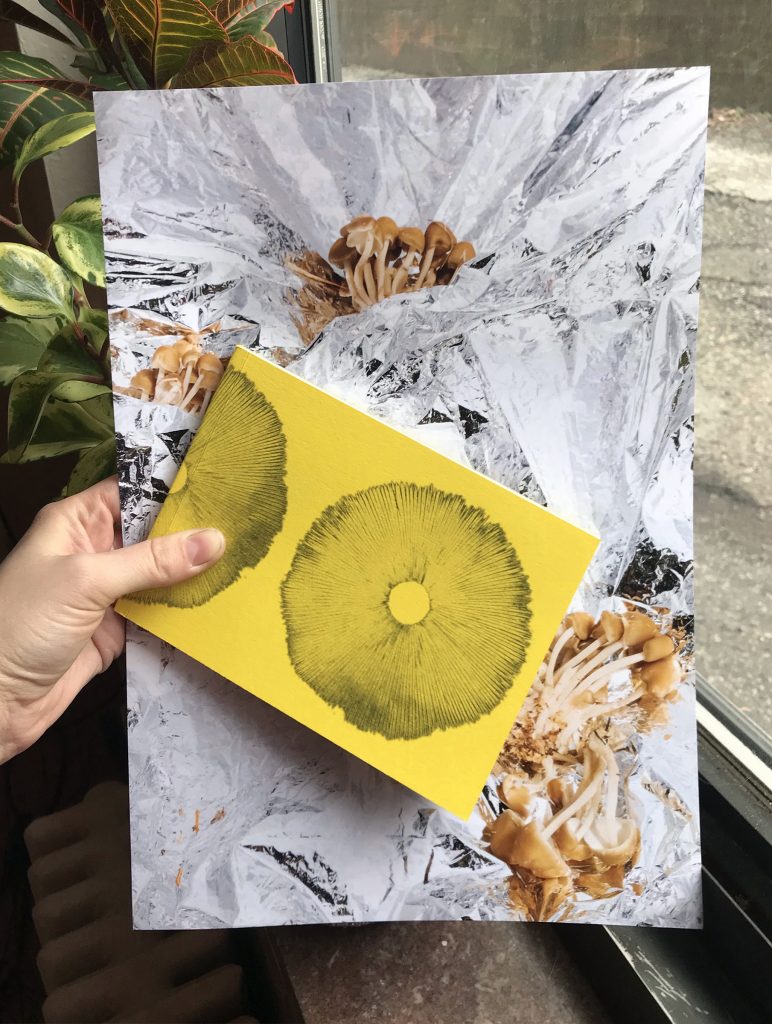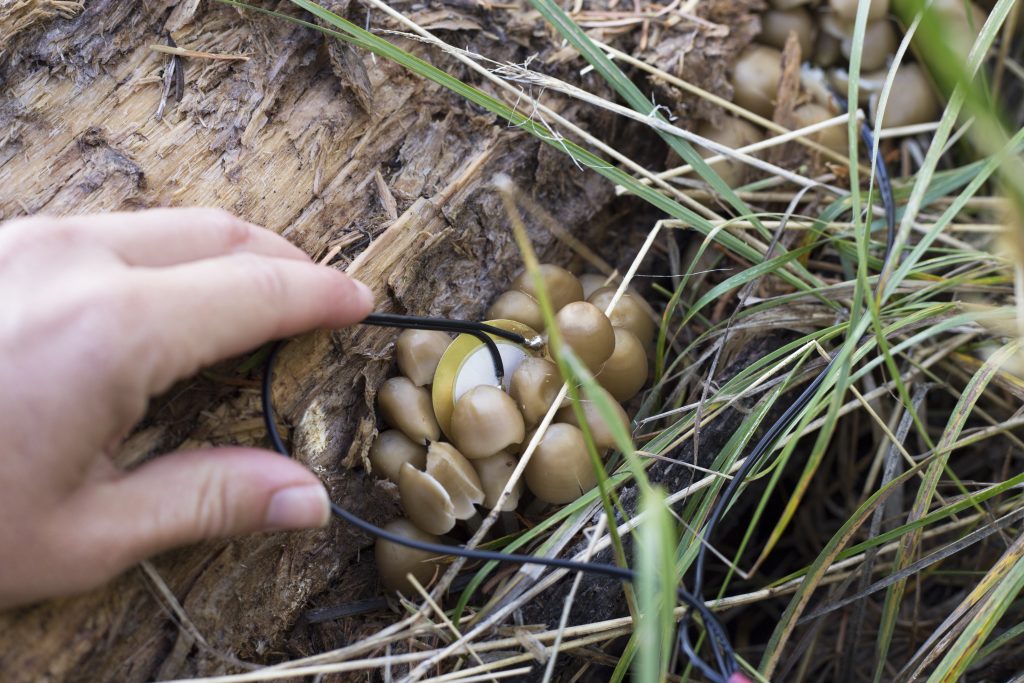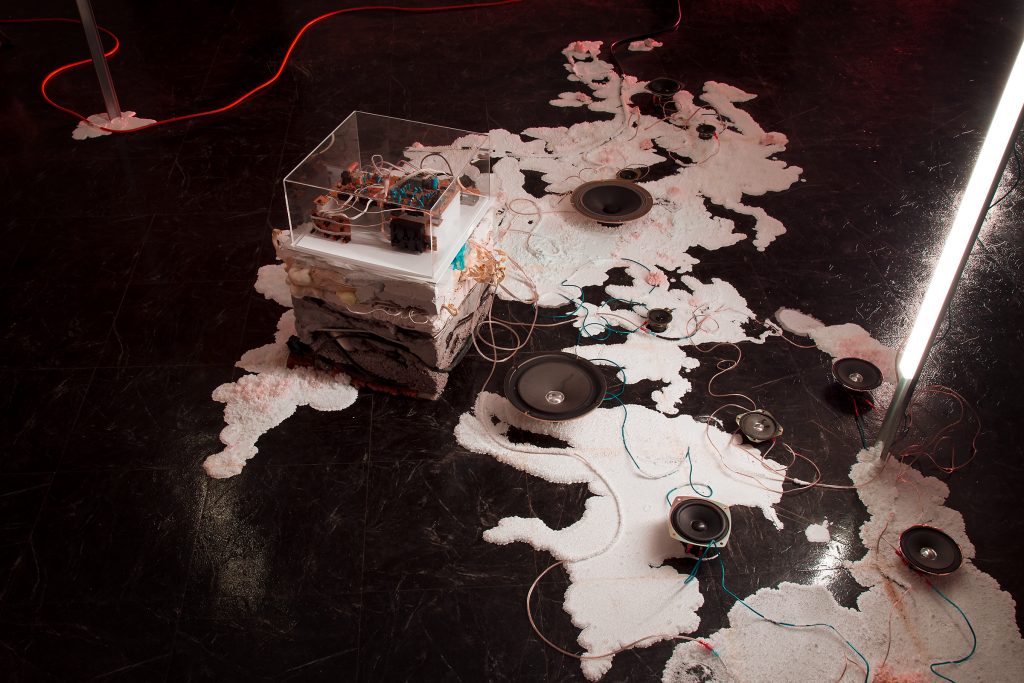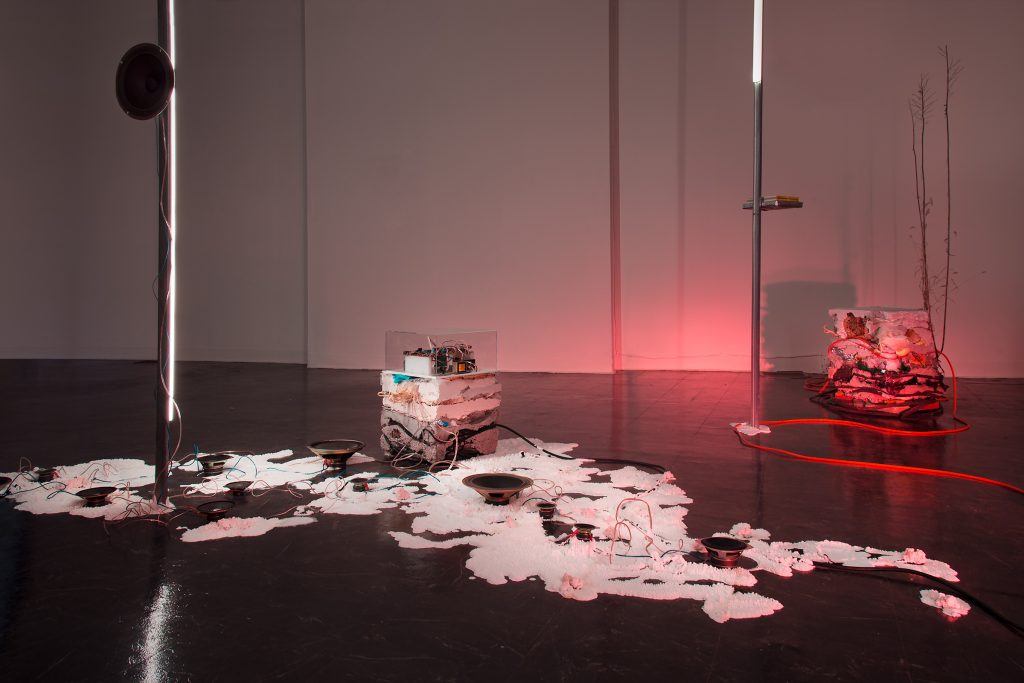On View: July 26 – September 23, 2020
Erin Mallea and Jen Vaughn’s work Cumulative Skies, Deep Soils is a rhizomatic installation of sounds, crystallizing spills, meteorites and mycelium. First displayed in early March 2020, immediately preceding the pandemic, the work addresses themes that have taken on new relevance in the intervening months — alienation, separation, and connection to the natural world and one another.
Oresman Gallery Student Assistant Paige Oliveira interviewed Mallea and Vaughn about the role of sensory experience in their research, their relationship to medium, and how the COVID-19 pandemic has affected their studio practice.

Paige Oliveira: Do you prefer your work to be more informative or reflection-inspiring for viewers?
Erin Mallea: I work toward finding a balance of the two, and my studio process is often spent trying to find the right combination. For me, art is a tool to examine the world around me, and research is central to Jen and my individual and collaborative practices. However, I think it’s important to translate research into work that is visually, sensorially, and emotionally engaging as an entry point to the information and its larger implications. Cumulative Skies, Deep Soils was influenced by the importance of a connection to the natural world that is beyond scientific and analytical: one that is also personal, emotional, and maintains an ongoing ethic of care, closeness, and awe. The power of art is that it doesn’t have to conform to the same expectations or parameters as other forms of research: art can collapse the cultural, playful, speculative and imagined simultaneously. This is especially important today when advances in science and technology have increased the nature-culture divide often alienating individuals and communities from the larger social and ecological systems we exist within. Cumulative Skies, Deep Soils started with Jen and my shared personal investment in the same geographic location as Refuge, my solo work that will be on view at Smith in 2021. I’m excited about how these projects might speak to and build on one another.
Jen Vaughn: Initially, my first aim is to capture a moment of surprise or reflection for the viewer—some sort of sensory engagement that pulls them in. It’s this experience that can lead to a more meaningful conversation or inquiry, particularly since a lot of my work is rooted in relation to ecology, the environment, and geology. While Erin and I both love doing research and talking through science, our integration of it is more speculative. For instance, we aren’t attempting to generate scientific knowledge through our mushroom vibration recordings, rather, we want to use them as means of generating sensory experience. It’s about another kind of knowledge, one both imagined and felt. This space of reimagining and valuing the sensory experience often falls outside the scope of scientific inquiry, for understandable reasons. For me, art opens up that possibility, to have both rational knowledge and the experiential come together in a way that generates authentic change and empathy.

PO: How much do you rely on text to supplement your works?
JV: I love text and writing that can accompany physical works. When I think about a show as a whole the text becomes a critical component–it can really open up and reveal the thinking behind the other pieces while also being a piece in itself. I suppose my goal of any text is to be both autonomous and connective, a bridge of sorts to network together the field of ideas, questions, musings. My texts are usually a combination of things- poems, research, documentation. Hopefully, for a viewer who wants more, a text can be just that–another way in and a platform for launching out, for asking more questions and wondering about other possibilities.
EM: Writing is an essential tool for me to process ideas in the studio, supplement works in an exhibition, or become part of a work itself. Like Jen, I incorporate text in a variety of ways including creative writing, interviews, and found or historic text. Since my work is often grounded in a particular conceptual, historic, or geographic context, it’s important that I work through a hierarchy of text and information: what should become part of the work itself, what information is a necessary entry point for viewers, and where and how can supplemental text exist? My goal is to create opportunities for viewers to engage with the work on different levels. Many of my recent projects include an artist’s book. I’ve found that this is a good method for me to create a repository of ideas, text, research and images that complement and complicate works in an exhibition but is not required reading to engage with the other works.

PO: How important is using multiple mediums for your work?
EM: My approach varies from project to project. Often it’s a question of deciding what material and approach makes the most sense for a particular work, context, or conceptual question. I tend to think conceptually before materially so it can take time to figure out what medium(s) to use. For me, material decisions come from research, immersion in a topic or place, and trial and error in the studio. I enjoy learning new skills and use a project idea as an opportunity to experiment with new methods. Many of my projects combine multiple works in conversation with one another. I find that utilizing different mediums helps me work through and pose multiple questions simultaneously (to myself and a viewer) while creating varied avenues of engagement for an audience.
JV: I never really enter into a project with specific mediums in mind, part of the freedom that comes in the contemporary art landscape is the ability to be really open and untethered to any medium. Generally, I start with a specific material I’ve stumbled upon–typically untraditional in nature (I can’t remember the last time I bought an actual art supply.) From there the work is about experimenting, responding, researching…most often these lead to a lot of failed ideas and piles of nonsense in the studio. I photograph these failures and pay attention to when I am trying to push a material too hard, to make it do something that it just doesn’t want to do. At some point in all these experiments I find a new avenue to pursue, a way to use the material in a format that feels cohesive or poetic.

PO: How has your current studio practice been influenced by the effects of the COVID-19 pandemic?
JV: For me the effect of Covid-19 has been really psychological, it has called into question art-making in general during a time of deep unrest and conflict. In that sense, I think it has both slowed down my practice but also provided space for reflection, for rest, and a chance to reform the way I go about things. Strangely enough, our latest project began from a space of distance, separation, and longing for connection. Many of these threads are being felt on a widespread scale with the pandemic, it was an uncanny parallel that we didn’t expect when we began the making the work.
EM: My practice has slowed down since the beginning of the pandemic for both practical and emotional/psychological reasons. Echoing Jen, I found myself distracted from my art practice and focused on the reality of the pandemic, fights for racial justice, and current American politics. Additionally, I find that I work best when I have an exhibition, opportunity or deadline to work toward and had residencies and exhibitions postponed or cancelled due Covid-19. So that forced a slowdown and shift that I ended up welcoming. Jen and I exhibited Cumulative Skies, Deep Soils in early March right before the shutdown. We didn’t realize how relevant the work was about to become. As Jen mentioned, it began as an attempt to bridge our personal physical distance (I live in Pennsylvania and Jen in Oregon) and transformed into a larger metaphor about alienation, separation, and connection to the natural world and one another. I’m grateful we were able to build and maintain a creative partnership across the country and for the many artists and organizations that have adapted to the pandemic and built collective opportunities, resources, and mutual aid for creative practitioners.
View Mallea and Vaughn’s full artist statement here.
View more of Mallea’s work at erin-mallea.com.
View more of Vaughns’s work at jenvaughn.com.
You must be logged in to post a comment.